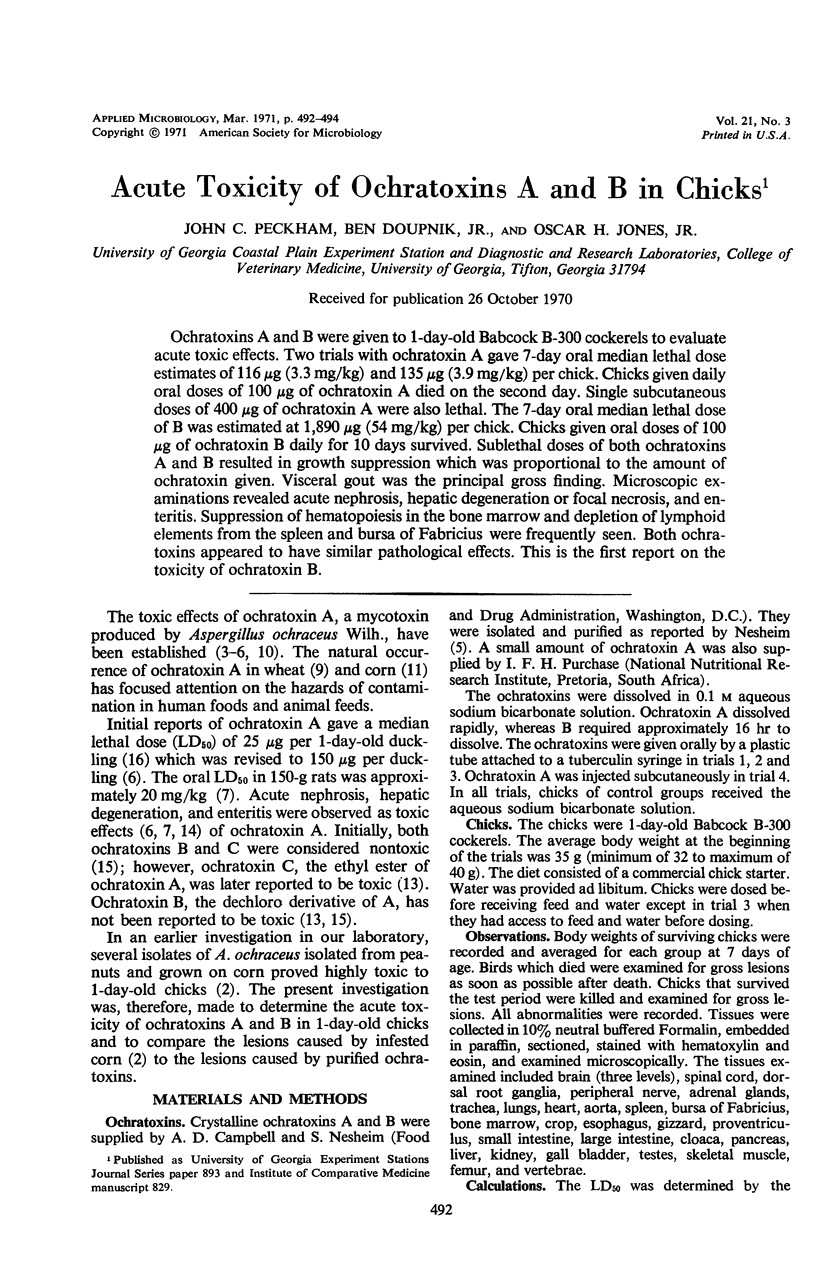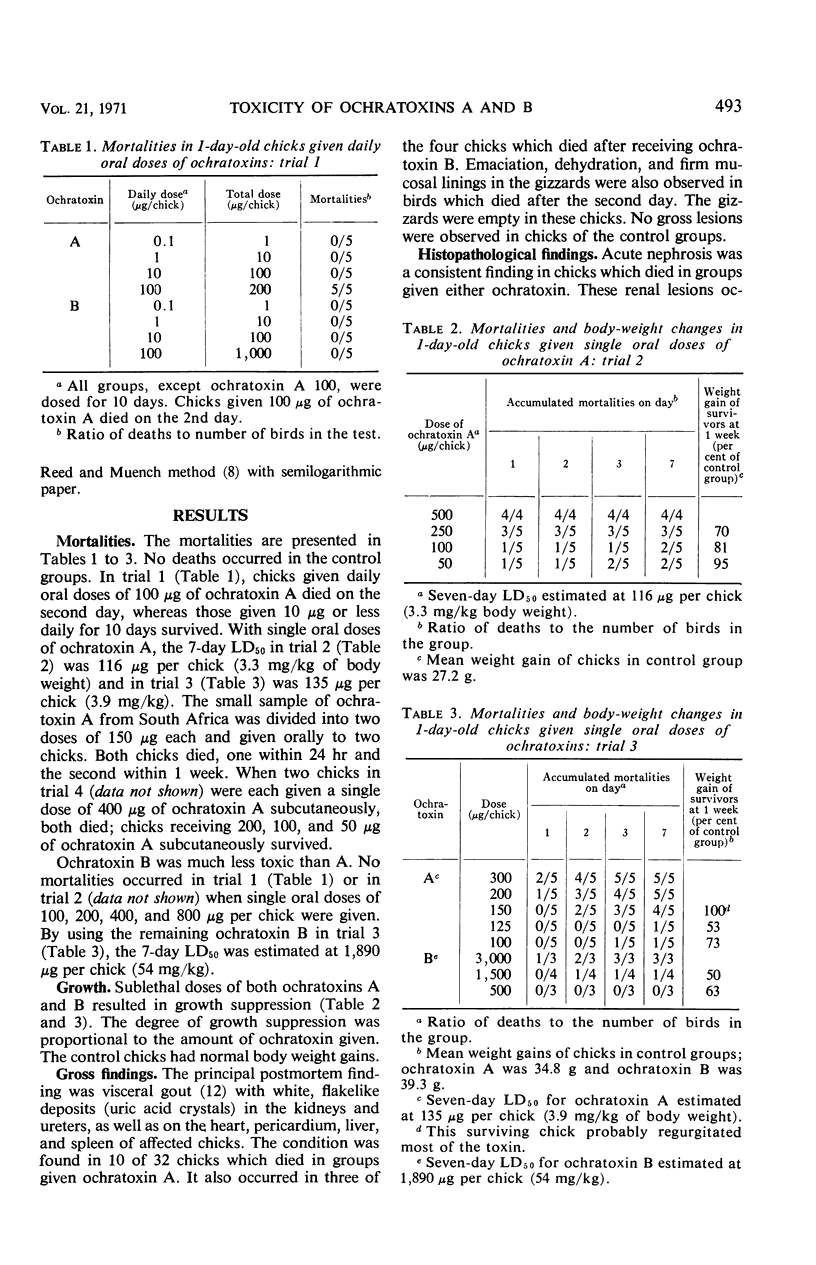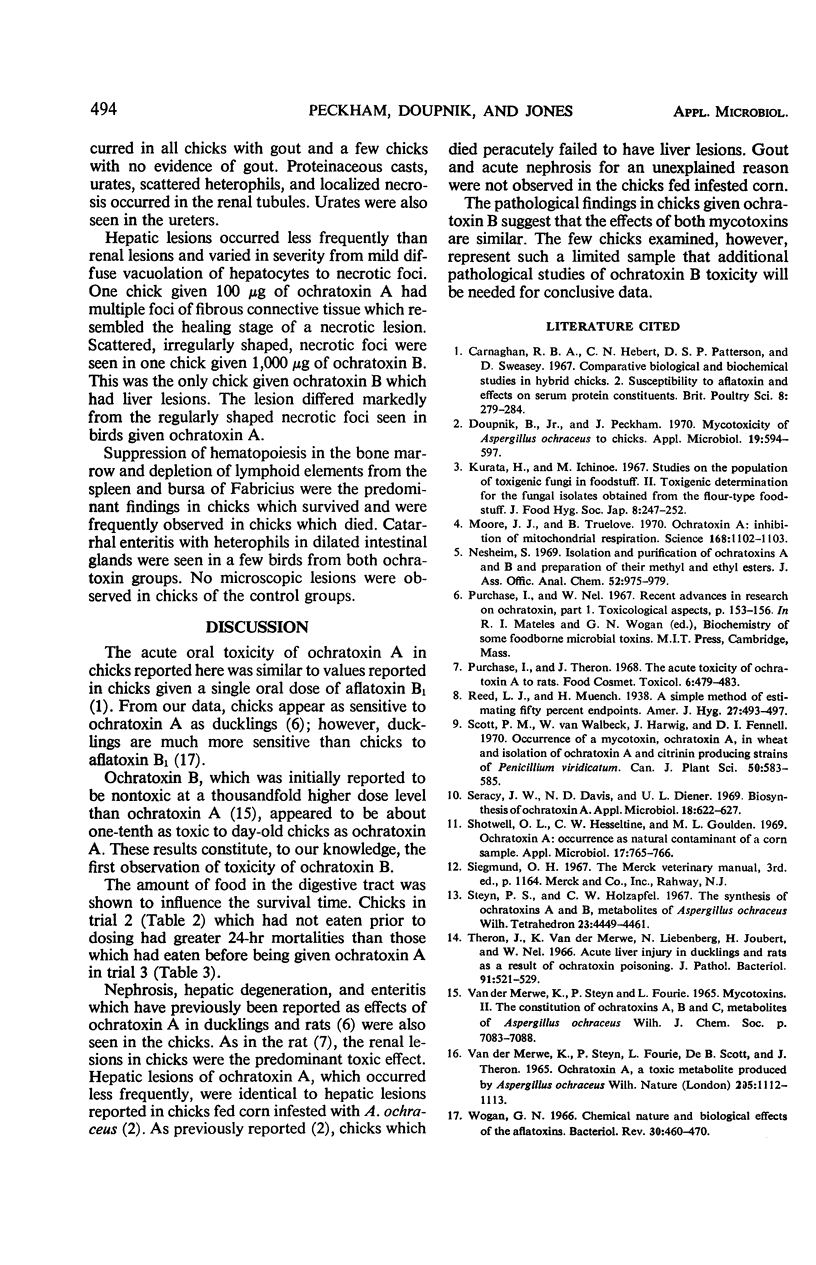Abstract
Ochratoxins A and B were given to 1-day-old Babcock B-300 cockerels to evaluate acute toxic effects. Two trials with ochratoxin A gave 7-day oral median lethal dose estimates of 116 μg (3.3 mg/kg) and 135 μg (3.9 mg/kg) per chick. Chicks given daily oral doses of 100 μg of ochratoxin A died on the second day. Single subcutaneous doses of 400 μg of ochratoxin A were also lethal. The 7-day oral median lethal dose of B was estimated at 1,890 μg (54 mg/kg) per chick. Chicks given oral doses of 100 μg of ochratoxin B daily for 10 days survived. Sublethal doses of both ochratoxins A and B resulted in growth suppression which was proportional to the amount of ochratoxin given. Visceral gout was the principal gross finding. Microscopic examinations revealed acute nephrosis, hepatic degeneration or focal necrosis, and enteritis. Suppression of hematopoiesis in the bone marrow and depletion of lymphoid elements from the spleen and bursa of Fabricius were frequently seen. Both ochratoxins appeared to have similar pathological effects. This is the first report on the toxicity of ochratoxin B.
Full text
PDF


Selected References
These references are in PubMed. This may not be the complete list of references from this article.
- Carnaghan R. B., Hebert C. N., Patterson D. S., Sweasey D. Comparative biological and biochemical studies in hybrid chicks. 2. Susceptibility to aflatoxin and effects on serum protein constituents. Br Poult Sci. 1967 Oct;8(4):279–284. doi: 10.1080/00071666708415680. [DOI] [PubMed] [Google Scholar]
- Doupnik B., Jr, Peckham J. C. Mycotoxicity of Aspergillus ochraceus to chicks. Appl Microbiol. 1970 Apr;19(4):594–597. doi: 10.1128/am.19.4.594-597.1970. [DOI] [PMC free article] [PubMed] [Google Scholar]
- Moore J. H., Truelove B. Ochratoxin A: inhibition of mitochondrial respiration. Science. 1970 May 29;168(3935):1102–1103. doi: 10.1126/science.168.3935.1102. [DOI] [PubMed] [Google Scholar]
- Purchase I. F., Theron J. J. The acute toxicity of ochratoxin A to rats. Food Cosmet Toxicol. 1968 Dec;6(4):479–483. doi: 10.1016/0015-6264(68)90138-7. [DOI] [PubMed] [Google Scholar]
- Searcy J. W., Davis N. D., Diener U. L. Biosynthesis of ochratoxin A. Appl Microbiol. 1969 Oct;18(4):622–627. doi: 10.1128/am.18.4.622-627.1969. [DOI] [PMC free article] [PubMed] [Google Scholar]
- Shotwell O. L., Hesseltine C. W., Goulden M. L. Ochratoxin A: occurrence as natural contaminant of a corn sample. Appl Microbiol. 1969 May;17(5):765–766. doi: 10.1128/am.17.5.765-766.1969. [DOI] [PMC free article] [PubMed] [Google Scholar]
- Steyn P. S., Holzapfel C. W. The synthesis of ochratoxins A and B metabolites of Aspergillus ochraceus Wilh. Tetrahedron. 1967 Nov;23(11):4449–4461. doi: 10.1016/s0040-4020(01)88843-8. [DOI] [PubMed] [Google Scholar]
- Theron J. J., van der Merwe K. J., Liebenberg N., Joubert H. J., Nel W. Acute liver injury in ducklings and rats as a result of ochratoxin poisoning. J Pathol Bacteriol. 1966 Apr;91(2):521–529. doi: 10.1002/path.1700910228. [DOI] [PubMed] [Google Scholar]
- Van der Merwe K. J., Steyn P. S., Fourie L. Mycotoxins. II. The constitution of ochratoxins A, B, and C, metabolites of Aspergillus ochraceus Wilh. J Chem Soc Perkin 1. 1965 Dec;:7083–7088. doi: 10.1039/jr9650007083. [DOI] [PubMed] [Google Scholar]
- Wogan G. N. Chemical nature and biological effects of the aflatoxins. Bacteriol Rev. 1966 Jun;30(2):460–470. doi: 10.1128/br.30.2.460-470.1966. [DOI] [PMC free article] [PubMed] [Google Scholar]
- van der Merwe K. J., Steyn P. S., Fourie L., Scott D. B., Theron J. J. Ochratoxin A, a toxic metabolite produced by Aspergillus ochraceus Wilh. Nature. 1965 Mar 13;205(976):1112–1113. doi: 10.1038/2051112a0. [DOI] [PubMed] [Google Scholar]


